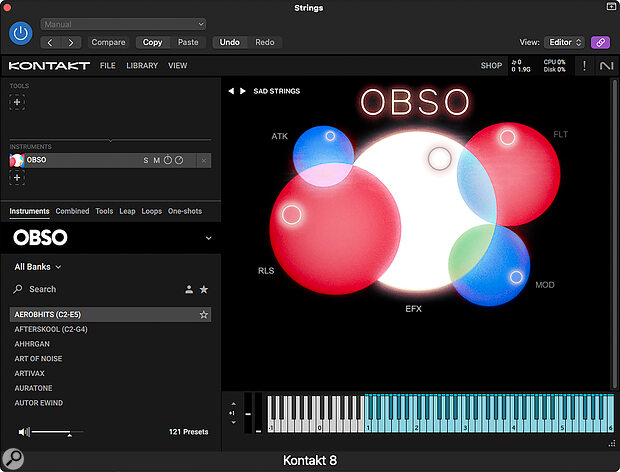Rating: ★ ★ ★ ★ 4/5 Stars
Running in Kontakt 7.10.5 and above (including the free Player), OBSO seems to be designed to satisfy those who want instant gratification and want it now! OBSO uses samples as its sound source, the focus of the instrument being obsolete media. Those behind OBSO clearly embrace the attractive lo‑fi aspects of cassette tape, warped vinyl, worn‑out VCRs and so on.
The interface is pleasingly simple. If you feel overwhelmed by software synths covered in arcane knobs and buttons, then OBSO will feel like a breath of fresh air — once one of the 121 preset patches is loaded, there are only five controls needed to massage it into shape. These controls are arranged as overlapping coloured circles with a circular blob within each to act as a pointer. Dragging this blob around adjusts the control. All very intuitive! To the left are controls for Attack and Release, which do exactly what you’d expect. This is simpler than the more usual ADSR envelope shaper but in the context of the sounds provided, it really is all you need. A keyboard graphic at the bottom of the window shows the note range of the patch in blue.
The large white circle is labelled FX, and in reality this is a macro control adjusting reverb, delay, modulation and stereo spread. Its exact function changes depending on the patch you’ve called up and it certainly adds richness and dimension to the sound. A no‑frills low‑pass filter is included and its frequency is also mapped to the mod wheel. Different patches appear to have different amounts of resonance dialled in, so you could automate this control if you really must go ‘zwee’. Finally we come to Mod, which is again patch dependent but tends to bring in the kind of wobbly, dusty artefacts we’ve come to expect from ancient tape echo units or abused cassette tapes. A patch browser allows the sounds to be viewed by type or by ‘recently used’, and the user can also mark favourites with a star.
If you imagine lo‑fi with a hint of Mellotron vibe, then that would be about right.
But what of the source sounds? The patches, which include one‑shots and loops, range from smooth pads, fat basses, shimmery bells, brass and nostalgic strings to aged piano and more. What’s more, it is surprising how effective the envelope controls are, especially on the string patches, which can go from slow and languid to staccato stabs using the same source preset. If you imagine lo‑fi with a hint of Mellotron vibe, then that would be about right. These sounds sit very well in a mix but have enough character to be used as solo elements too. OBSO may be simple but it has an endearingly retro character.

